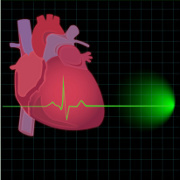Just when you thought it was safe to come in off the treadmill, yet another type of fat risk rears its ugly head at our hearts sending us right back for more hours of climbing virtual mountains. The culprit this time? Pericardial or heart fat. Heart fat? Yes, my sisters -– you heard correctly -- heart fat. Heart fat! Does this mean that my heart gets fat like the rest of me? Just what is pericardial fat?
Most of us, particularly women, are familiar with subcutaneous and visceral fat. Subcutaneous fat is the visible calling card left around our waists by excess weight. Personally, I refer to this type of fat as the fat that makes me look like the Stay-Puff-Marshmallow-Girl. Visceral fat is fat which is deeply buried underneath the layers of subcutaneous fat. It settles around your organs causing real damage and leading to numerous health problems, including heart disease. Visceral fat is kind of like the little brother who sneaks into the back seat and comes along on your date and you don’t know that he’s there until he pops his head up yelling –- Surprise! Of course, then it’s too late. That’s visceral fat.
Visceral belly fat is a real danger to your heart health and a leading risk factor in the development of heart disease. If you thought visceral belly fat was dangerous to your heart health, then you haven’t seen anything yet. Look to stage left -– enter Pericardial Fat.
Pericardial fat, or fat deposits around the heart, has long been thought to simply be a part of normal aging. You get older and you develop pericardial fat. Even a thin person can develop pericardial fat. Pericardial fat emits cytokines, which are an inflammatory protein. Exposure to these inflammatory cytokines leads to coronary atherosclerosis which, of course, is the leading contributor to heart disease.
A recent study conducted at the Wake Forest University Baptist Medical Center studied pericardial fat as it related to the development of heart disease. None of the study participants had a prior history of heart disease. As a part of the study, all participants underwent a CT scan to measure their existing levels of calcified coronary plaque. Calcified coronary plaque is a precursor to developing coronary atherosclerosis. The researchers also examined the results of the Multi-ethnic Study of Atherosclerosis (MESA), a larger, nationwide 6800 participant study in drawing their conclusions.
The CT scan revealed that 58% of all participants showed the presence of calcified coronary plaque at the beginning of the study. However, those participants with pericardial plaque were found to have the highest levels (almost five times -- 4.65% -- more than other participants) of calcified coronary plaque. At the end of this study, it was reported that the main culprit in the development of heart disease was not BMI, waist circumference, ethnicity or gender. The main culprit leading to the development of heart disease was the amount of pericardial fat present around the heart. There was a direct correlation between the amount of pericardial fat and the risk of developing heart disease. The higher the level of pericardial fat –- the greater the risk.
Fat deposits cause inflammation. Pericardial fat, in particular, gives off cytokines, a highly inflammatory protein. It’s believed that long-term exposure to cytokines and inflammation cause the calcification process to go into overdrive and accelerates the calcification process. This constant exposure to inflammation is believed to increase the risk of developing heart disease and to be a greater risk factor than BMI, obesity or waist circumference.
Regarding their findings, researcher Jingzhong Ding, M.D., stated “Our findings suggest that local fat deposits, rather than the total body fat, are most related to calcified coronary plaque.” (Science Daily) The next step will be to determine if there are ways to reduce pericardial fat in order to lessen the risk of the development of heart disease.
Until next time, here’s wishing you a healthy heart.
Sources:
Jody Cross, Fat Around the Heart: A Danger to Your Health, 04 Aug 2008, Health News, http://www.healthnews.com/disease-illness/fat-around-heart-a-danger-your-health-1522.html
Fat Around The Heart May Increase Risk of Heart Attacks, Science Daily, 31 Jul 2008, http://www.sciencedaily.com/releases/2008/07/080730140611.htm
(Disclaimer: I am not a physician and nothing in this article should be construed as giving medical advice. As with any medical decision, please consult your physician.)





Add a Comment4 Comments
This is so interesting, and I ended up here in a rather different way. I was reading the discharge papers sent to me by my parent's vet, their very obese and very sweet kitty was struggling to breathe and I thought it more than likely was because of carrying 3 times more body weight than her little frame should have.
January 22, 2016 - 10:15pmThings looked good, but there was mention of "pericardial fat", which I needed to Google. So I have really learned this week that we ladies do, for our health in so many ways, need to keep movin'. I have Fibromyalgia and exercise sometimes is the last thing i can even imagine doing. But the heart is a muscle too, and we want strong muscles to keep our bodies working the best they can.
I feel newly inspired to get myself and my cat friend into shape. (And it has always been my understanding that we really get rid of all fat the same way, that there really is no special way to "trim your bum" or whatever the magazines say :) Good food and good exercise! Thank you so much for the article and I know Kitty will thank you too ;-)
(this captcha is haaaaard! One more try, i can barely make out what this is, and I promise I am not a robot :0))
Amy Lynn Hunt
This Comment
Hi Diane... Yes, we can get rid of visceral fat through exercise. The interesting thing is that just not any normal exercise will get rid of visceral fat. We have to do specific exercises that target the deep lower abdominal muscles. The Mayo Clinic listed some specific exercises that target the visceral fat. The exercises are described here: https://www.empowher.com/news/herarticle/2009/05/07/how-get-rid-menopause-belly-fat
I had the same question as you about the pericardial fat. One of the things that concerned me is that we develop a certain amount of pericardial fat naturally as we age so it's important not to add more. I'm looking now for the answer to whether or not simply diet alone will reduce the pericardial fat or if there are other actions we need to take. I'll let you know what I find out.
January 20, 2010 - 11:31amThis Comment
Awesome. Thanks for the link to the exercises (how did I miss that before?) and I'll wait for the answer to the pericardial fat.
January 21, 2010 - 9:31amThis Comment
Mary,
I learned so much from this post. It was thorough, informative and gave me just enough detail. Thank you for wading through the scientific mumbo-jumbo to teach me something really important.
I have a question for you. When we work to lose our fat, can we also ultimately lose the visceral fat and the pericardial fat?
January 19, 2010 - 8:57amThis Comment